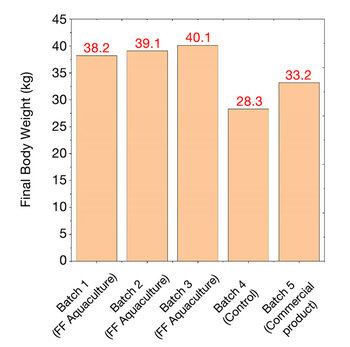The co-culture of probiotics in aquaculture production is proving to be a game-changer for the industry. By introducing multiple beneficial bacterial strains into the feed food, farmers can significantly enhance the overall health and productivity of their fish. These probiotics work synergistically to improve water quality, boost the immune systems of the fish, and promote better nutrient absorption and growth rates.

Technical Sales Analyst
Bialtec
Aquaculture activities have experienced significant growth worldwide, emerging as a crucial contributor to the global food production sector. According to the United Nations Food and Agriculture Organization (FAO), global aquaculture production has risen to over 114 million tons as of 2020, with an average annual growth rate of 5-6% over recent decades. Key contributors to this growth include the intensification of farming practices, technological advancements, and increased demand for fish as a healthy protein source Despite advancements in farming techniques and disease management, challenges such as disease outbreaks, climate change, and market fluctuations persist. Sustainability efforts focus on reducing environmental impacts through better water management, reduced chemical use, and improved waste management, underpinned by evolving regulatory frameworks to ensure product safety and sustainability.
Particularly, the application of probiotics is a promising alternative to antibiotics for disease management in aquaculture. Probiotics are live microorganisms, which when administered in sufficient amounts, confer beneficial effects on the host (FAO). These probiotics reconfigure the intestinal microbiome toward a more efficient and healthy state, optimizing nutrient absorption, promoting animal health, replacing antibiotic growth promoters, and minimizing environmental impact. However, it is necessary to establish criteria for the selection of a functional additive, particularly microorganisms, and microbiomes, such as tolerance to acid, heat, and oxygen; capacity for adherence and colonization to the epithelium; ability to stimulate an immune response; antagonisms to pathogens; ability to improve host digestion, conservation, and viability problems during the processing. The efficacy of probiotics is not just restricted to the gastrointestinal tract, but it plays a significant role in improving the overall health of the host by promoting growth, enhancing immune parameters, and improving the quality of the culture water (Leong et al., 2023). The addition of probiotics to the aquaculture system has been proven to improve growth performance, water quality, and disease resistance of tilapia, Oreochromis sp. (Chauhan et al., 2019).
![]() BOOSTING TILAPIA HEALTH AND GROWTH WITH FORTCELL FEED AQUACULTURE PROBIOTICS
BOOSTING TILAPIA HEALTH AND GROWTH WITH FORTCELL FEED AQUACULTURE PROBIOTICS
Given the environmental stresses and challenges associated with aquaculture production, the choice of feed additives and dietary modulators is crucial for improving weight gain and reducing mortality rates. Over the years, various feed additives have been suggested, including bacteriophages, botanical products, organic acids, probiotics, prebiotics, and more. However, most of these additives have only been proposed as potential agents, with minimal research conducted on their combined use and synergistic effects.
The co-culture of probiotics in aquaculture production is proving to be a game-changer for the industry. By introducing multiple beneficial bacterial strains into the feed food, farmers can significantly enhance the overall health and productivity of their fish. These probiotics work synergistically to improve water quality, boost the immune systems of the fish, and promote better nutrient absorption and growth rates. Co-cultured probiotics, such as Bacillus subtilis and Bacillus licheniformis, effectively break down organic matter, reduce harmful nitrogen compounds, and maintain optimal pH levels. This holistic approach not only leads to healthier and more resilient fish but also supports a more sustainable and efficient aquaculture system.
Our study conducted in the Department of Huila, Colombia, has shown that the introduction of Fortcell Feed Aquaculture probiotics not only enhance the growth and health of Nile tilapia (Oreochromis niloticus) but also improve the overall water quality in fishponds.
Fortcell Feed® Aquaculture contains a mix of probiotics and prebiotics (Bacillus subtilis, Bacillus licheniformis, inulin and β-glucans), free of antibiotics and highly productive.
THE STUDY AND ITS FINDINGS
The study involved 541.600 Nile tilapia fingerling, each weighing around 4 grams at the start. These fries were divided into five groups and placed in separate earthen ponds. Three of the groups received the Fortcell Feed Aquaculture probiotics, while one group served as a control with no additives, and the last group used a commercial product.
Over a 45-day period, the researchers meticulously recorded data on weight gain, survival rates, and the physicochemical properties of the pond water. The results were nothing short of impressive.

SUPERIOR GROWTH AND WEIGHT GAIN
The fingerlings in the ponds treated with Fortcell Feed Aquaculture probiotics showed a notable increase in weight gain compared to both the control group and the group using a commercial product. The daily weight gain for the probiotic-treated groups ranged from 0.876 to 0.899 grams per day, significantly higher than the control group’s 0.830 grams per day and the commercial product group’s 0.844 grams per day. At the end of the trial, the overall final weight was higher for the probiotics group than for both the control and commercial product groups (Figure 1).
These results highlight the benefits of beneficial bacterial strains that multiply in the gastrointestinal system, aiding food absorption and digestion through the use of epithelial cells. The potential significance of probiotics could be associated with their role in improving feed intake. It has been demonstrated that Bacillus species increase the total protein content of Nile tilapia, which is consistent with our findings. Probiotics, therefore, enhance intestinal immune responses against infections and increase the total protein content in fish meal.

LOWER MORTALITY RATES
One of the critical outcomes of this study was the reduction in mortality rates among the tilapia fingerlings (Figure 2). While tilapia is generally more resistant to bacterial, parasitic, fungal, and viral diseases compared to other cultured fish species, intensive farming practices have increased their susceptibility to various diseases. Among these, streptococcal infection caused by Streptococcus sp. is particularly significant, leading to mass mortality and substantial economic losses in Nile tilapia (Oreochromis niloticus).
In our research, the groups treated with Fortcell Feed Aquaculture probiotics experienced significantly lower mortality rates compared to the control and commercial product groups. This indicates that Fortcell Feed Aquaculture probiotics not only promote growth but also enhance the overall health and resilience of the fish. This can be attributed to the Bacillus species, which exhibit potential antimicrobial activities and an immunostimulant effect. Beneficial microbes that dominate the gut microbiome also help lessen the detrimental effects of pathogenic microorganisms on gut immunity.
IMPROVED WATER QUALITY
In addition to the traditional focus on efficiency and profitability, today’s customer is increasingly concerned about the environmental impact of their farming operations. They are actively in search of sustainable practices and feed options that can reduce their carbon footprint. These discerning customers closely monitor market trends and respond to evolving consumer preferences, tailoring their feed choices accordingly.
The study also highlighted the positive impact of probiotics on water quality. Key parameters such as pH, temperature, and dissolved oxygen levels remained within optimal ranges in the ponds treated with probiotics (Table 1). Additionally, the levels of harmful nitrogen compounds (NO2 and NH3) were lower, and the more easily assimilable NH4 was also reduced, suggesting a healthier and more balanced aquatic environment. Probiotics, including Bacillus sp., demonstrate their ability to enhance pond water quality by breaking down organic matter and releasing CO2, which is particularly advantageous during intensive production.
![]() ECOLOGICAL AND BIOLOGICAL BENEFITS
ECOLOGICAL AND BIOLOGICAL BENEFITS
The ecological and biological conditions of the ponds treated with Fortcell Feed Aquaculture probiotics were more stable and conducive to the growth of the tilapia fingerlings. The consistent temperature, adequate oxygen levels, and balanced pH contributed to a thriving aquatic ecosystem, further supporting the health and development of the fish.
CONCLUSION
The use of Fortcell Feed Aquaculture co culture probiotics in tilapia farming offers a promising solution for enhancing fish health and growth. The study conducted in Huila, Colombia, provides compelling evidence that these probiotics can significantly reduce mortality rates, increase weight gain, and improve water quality. For fish farmers, this means a more efficient and sustainable way to raise healthier and more robust tilapia.
By integrating Fortcell Feed Aquaculture probiotics into their farming practices, aquaculturists can look forward to better yields, healthier fish, and a more balanced and productive aquatic environment. This innovative approach not only benefits the fish but also contributes to the overall sustainability and success of the aquaculture industry.
References:
1. Chauhan, A.; Singh, R. Probiotics in aquaculture: A promising emerging (2021). Alternative approach. Symbiosis 2019, 77, 99–113.
2. SS Leong, F Korel, AD Lingoh, SR Sarbini, SC Toh, LY Abit, SC Wong. Current probiotics application for aquaculture feed: a review. Borneo Science Journal. Volume 44 (Issue 2), September 2023
About Catalina Bedoya Ortiz
Catalina Bedoya Ortiz graduated as a Zootechnician from the University of Antioquia with a specialization in Project Management and is a candidate for a Master’s Degree in Animal Sanitation and Production. She has experience in Aquaculture and other production species, also has a focus on animal health and welfare. Ortiz is a researcher in gut microbiota and probiotics and works as a Technical Sales Analyst at Bialtec.